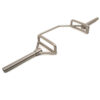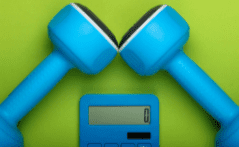Fitness
Maximal heart rate (MHR) calculator
What does heart rate mean?
Heart rate is the speed of an individual’s heartbeat, measured as the number of beats (contractions of the heart) per minute.
Heart rate is often abbreviated as simply BPM (beats per minute). For example, if your heart rate is 75 beats per minute, it may be written as: 75 BPM.
What does maximal heart rate mean?
Maximal heart rate, often abbreviated as MHR or HRmax, is the fastest rate that an individual’s heart is capable of beating.
Maximal heart rate can be reached by exercising at the highest possible intensity that a person can safely endure. It can also be estimated using our Maximal Heart Rate Calculator, which is a much faster and safer approach.
Some exercise programs will specify a target heart rate (THR) to indicate the desired level of difficulty (exercise intensity). This is typically expressed as a percentage of maximal heart rate. For example, a workout program may include a THR range of 50 to 70 per cent of maximal heart rate.
Predicting maximal heart rate
An individual’s maximal heart rate can be estimated using an equation proposed by Hirofumi Tanaka, Kevin D Monahan and Douglas R Seals. They found that maximal heart rate can largely be predicted by age alone.
Maximal heart rate estimation has some advantages over direct testing of maximal heart rate, including:
- direct testing may be risky (potentially unsafe) for some people;
- participants may struggle to reach their maximal heart rate, particularly if they have little or no experience with exercise; and
- estimation of maximal heart rate is much faster than direct testing.
However, it’s important to remember that it’s just an estimation; and the results of this calculation will not be as accurate as direct testing.
Maximal Heart Rate Calculator
This calculator uses the Tanaka, Monahan and Seals equation.
How maximal heart rate is calculated
The calculation for predicting maximal heart rate is:
208 – (0.7 x age) = predicted maximal heart rate (PMHR)
Equation proposed by Hirofumi Tanaka, Kevin D Monahan and Douglas R Seals (2001) and published in Essential Guide to Fitness for the Fitness Instructor, Rosemary Marchese, 2016.
For example, if an individual is 37 years of the age, then the calculation would be:
208 – (0.7 x 37) = 182.1 PMHR
Another quick method for estimating maximal heart rate
Whilst the Tanaka, Monahan and Seals equation detailed above is preferred, there’s another quick way to estimate a person’s maximal heart rate.
The calculation is:
220 – age = predicted maximal heart rate (PMHR)
For example, if an individual is 37 years of the age, then the calculation would be:
220 – 37 = 183 PMHR
The difference between this simpler calculation and the widely preferred equation from Tanaka, Monahan and Seals becomes more pronounced for young or elderly people, for example:
67 years old:
- Tanaka, Monahan and Seals result: 161.1 PMHR
- Simpler calculation result: 153 PMHR
17 years old:
- Tanaka, Monahan and Seals result: 196.1 PMHR
- Simpler calculation result: 203 PMHR
We’ve included details for the simpler calculation in this article, as some people still use it. However, we recommend using the Tanaka, Monahan and Seals equation. Better yet, simply use our Maximal Heart Rate Calculator!
How to measure your heart rate
There are a number of ways to measure your heart rate.
Checking your pulse
One method that many people are familiar with, is measuring your heart rate using the pulsation of an artery (i.e. ‘checking your pulse’). For example, you can measure your heart rate using your radial artery, by pressing your index and middle fingers on the ventral aspect of your wrist, just below your thumb. Count the number of pulsations during a one minute period to get your heart rate. You could also count the pulsations for just 15 seconds and then multiple the result by four.
Another easily accessible artery for measuring your heart rate is the carotid arteries in the neck, which are located on either side of your windpipe. Only light pressure should be applied and only one of these arteries should be checked (not both at once).
Given the difficulties of checking your pulse in the midst of exercise, this method is only viable for measuring your heart rate before or after an exercise session.
The easy way!
The easiest way to measure your heart rate is to simply wear a ‘fitness tracker’ or a watch with a heart rate monitor on your wrist. There are many products to choose from, but we recommend the following options for the best performance and value for money:
The beauty of these devices is that you can see your heart rate at a glance: before, during or after exercise.











